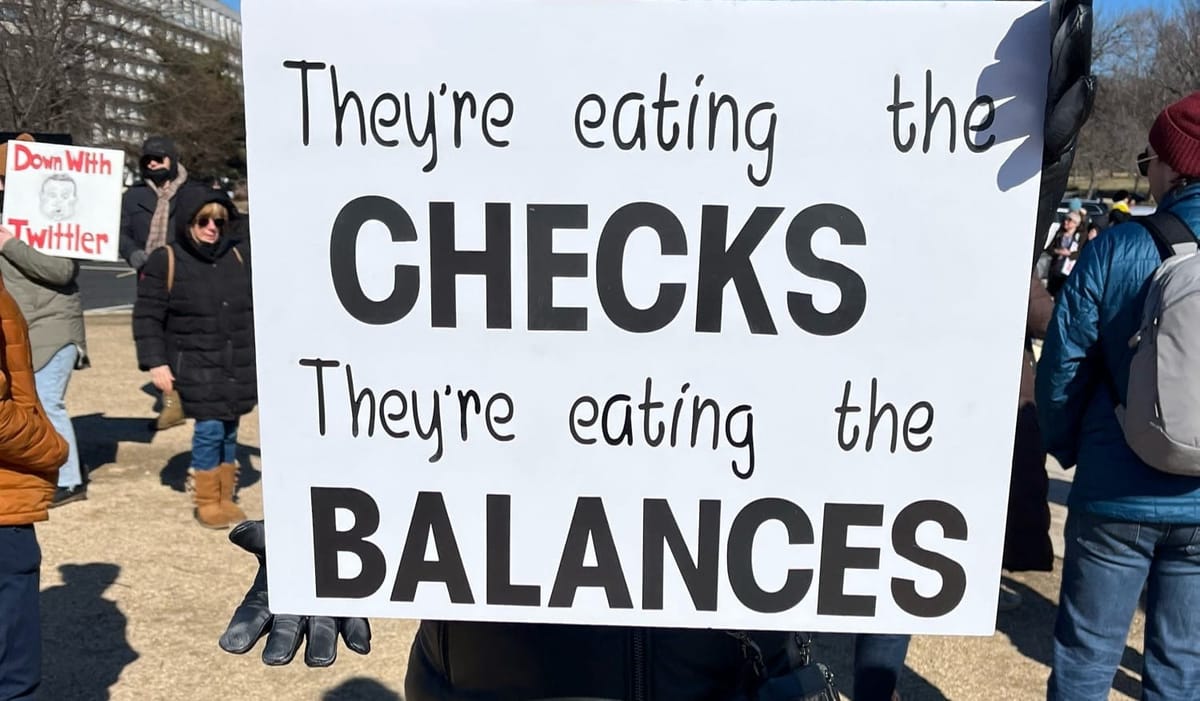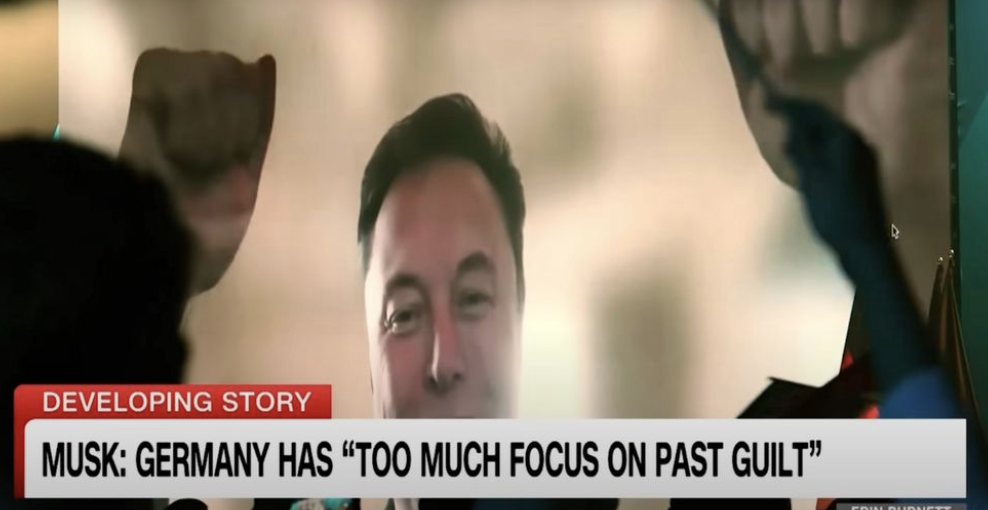Long Way From A Fire
Elon Musk has helped focus the anger of anti-fascist Americans

The lady sipped her latte and lectured me about being mean to fascists.
It was during one of the early mass anti-Trump protests in 2017, and I was standing in line at a D.C. coffee shop after protesters had dispersed. I wore a green t-shirt with an acoustic guitar at the center surrounded by the words This Machine Kills Fascists, the words etched on Woody Guthrie’s guitars in the early and mid 1940s, back when Americans largely agreed that fascism was, in fact, bad.
“You know you’re as bad as they are,” a middle-aged woman said to me, glancing at my shirt before sipping from her latte, arching an eyebrow and waiting for my response. “You’re advocating violence, just like they do.”
I appreciate the folks supporting BFT. Consider subscribing for $3 or $5 a month, or leaving a tip!
I suppressed the urge to lose my shit and calmly explained the history of the phrase, how Guthrie inspired other artists of the time to use their art in the existential fight against the fascist menace trampling Europe. Latte Lady quickly shifted.
“So you’re assuming they’re all fascists?” she asked. “Seems presumptuous.”
I was angry – stooped in an emotional defensive crouch – but also alarmed. This lady – and maybe many others who had come out to march against our first explicitly anti-democracy president – did not seem to grasp the threat, to understand the situation.
Latte Lady would have been shocked and horrified at what she was on Monday afternoon in Washington, D.C., when thousands gathered near the U.S. Capitol to protest Elon Musk’s coup and the end of constitutional governance in the United States. Strolling from the Judiciary Square Metro stop to the protest rallying point, I was struck by a two things: The size of the crowd – I’d estimate there were upwards of 8,000 people there – and the overwhelming presence of American flags waving in the bitter February wind and the protest signs calling the president and Musk fascists. This was not the same resistance I saw in 2017. There was something far more honest, clear-eyed, and urgent about this protest.
There remained a level of disorientation, of course. So many of the thousands who gathered in DC to push back on the world’s richest man taking over every aspect of the American government had been laid off by his escapades, which he clearly and maddeningly sees as a game in some history-altering troll campaign. A small army of black-pilled hackers, at least one of whom happily posts about reading neo-nazi authors, have invaded every part of the federal government and are haphazardly slashing government funding that will soon cost lives, devalue the dollar, and tank the American economy. To be disoriented amid all this is to be alive and conscious.
(As Laurence Tribe, professor of constitutional law at Harvard, told The New York Times: "Our Constitution rebels against the idea of empowering any individual, neither elected nor officially appointed pursuant to law, with the sweeping power to control the expenditure of public funds, the hiring and firing of public officials, the deployment of public force, and the organization of public agencies. This is brute dictatorship of the worst kind.)
Still a lot of people who care
— Denny Carter (@dennycarter.bsky.social) 2025-02-17T17:06:20.287Z
We weren’t quite sure what we were facing in 2017. A racist game show host had accidentally won the presidency and had no concrete plan for governing. Those working in his hastily-assembled administration couldn’t figure out how to turn on the White House lights on their first day in power. The new president didn’t believe in anything – he still doesn’t – but was monstrously racist and a longtime sexual abuser who may or may not go along with Republicans’ anti-abortion crusade. Beyond that, we didn’t know much about what was in store. Probably that’s why the mass protests in the first sixty days of the first Trump administration seemed (relatively) unfocused, sometimes even directionless. We were angry and confused – of course we were. About what we were angry and confused largely depended on who you asked in the crowds marching down the streets of every major American city.
Musk’s entry into the fascist equation seems to have helped focus the crowd’s anger, for he is the One Who Was Promised by the Supreme Court’s anti-democracy Citizens United ruling twelve years ago. We had become accustomed to foreign corporations and governments pouring untold money into our elections, for that was the goal of Citizens United. But to have a foreign-born billionaire buy the White House, then run the White House – that was an entirely new and different and dangerous little game, something beyond the worst nightmares of oligarchy. Musk has sharpened the focus of those who have been dimly aware of a certain unease in the air. For that, I suppose, we should be grateful.

Musk’s takeover of the U.S. government is the difference between 2017 and 2025: Eight years in which pro-democracy forces did nothing to protect the system and guard against the hostile takeover of the brainworm-infested product of capital. It is the ultimate manifestation of the rise of technofascism, a societal disease which threatens everyone and will forge some (very) unlikely alliances in the coming years. Congressional Republicans are no longer the primary threat. Neither are the far-right think tanks that held such sway during Trump’s first term. It is Musk and Musk alone who represents an existential crisis for the US, the most acute crisis in the nation’s history, and folks gathered in D.C. on Monday seemed to recognize that.
‘There Is No Middle Ground’
“ELON MUSK’S GRANDFATHER IS BURNING IN HELL,” a man shouted from behind me on Monday in DC, shortly after speeches – most of them underwhelming – got underway. The outburst drew laughter and fired up the crowd in ways the prepared remarks could not. There seemed to be an understanding of Musk’s legacy and a connection to past fights against anti-democracy forces that had squirmed their way into power.
Next to signs depicting Musk feeding a child into a wood chipper and Musk the puppeteer making Trump dance and playful references to the invading technofascist forces known as DOGE were signs acknowledging previous generation’s battles against fascism. A narrative seems to be forming between those fights and our current predicament. One sign read: My grandpop fought fascism and he would be really pissed at all this.

It’s not difficult to forge such a narrative. Musk himself gave us the imagery to fuel the story with his Inauguration Day straight arm salute that looked an awful lot like You Know Who (and was later dismissed as a Roman salute, a nice little gaslighting by a movement of professional gaslighters). It’s a big positive, in my view, that people are crafting stories about their place in the historical continuum as we face a string of frighteningly historical moments. Humans need narratives. The right understands this well. Maybe the left can too.
The prevalence of American flags waving atop the D.C. crowd was a stark departure from 2017 anti-Trump demonstrations. There was an overwhelming sense back then that Americans had let themselves down, and an understanding that Trump was a purely American creation, a projection of our worst angels come to life. In this light, it was tough – bordering on impossible – to save the red, white, and blue. But a weird thing happened in the interim: Anti-Trump parts of society claimed patriotism for their own and cast their foes as enemies of the country. This marked a strange, sometimes head swirling shift in the culture – one we saw come to a head in the final weeks of the 2024 campaign, when Kamala Harris took the formerly noncontroversial “America good” stance while Trump was brutally clear: “America bad.”
A woman identifying as an immigrant and wearing a Luigi hat shouted into a microphone, the first fired-up speech of the day at the DC rally, saying she had spent countless hours protesting in front of the Supreme Court over the past five years while the Court’s right-wing steadily dismantled the republic. On most of these days, sometimes in the blistering summer heat, she was alone, and would have to explain to passersby why she was there and what she was protesting. That Americans seemed unaware or unconcerned while a captured, corrupt, totally unaccountable institution rolled back the 20th century with every ruling was unfathomable to this woman. She seemed to understand how bad actors could so easily weaponize our civic ignorance against us.
“I was sold on American constitutionalism and exceptionalism,” she yelled over the crowd, her voice hoarse and fraying in the frozen February air. “Today I feel bamboozled.”
A humble request
— Denny Carter (@dennycarter.bsky.social) 2025-02-17T17:13:02.039Z
"There is no middle ground anymore," an elderly woman said to what appeared to be her husband near the back of the crowd (Monday's gathering skewed older and female, with young men nowhere to be found unsurprisingly).
It was comments like these that differentiated this action with the rallies in the first months of the first Trump term. There was a (misplaced, deeply naive) sense that Trump was such an outlier, so out of touch with the electorate, that Democrats and even some elected Republicans would stymie his entire agenda. This Sorinkesque belief in the inevitability to bipartisanship was just enough to make folks believe there was a middle ground, a compromised path out of Trumpism. We tried that with Joe Biden and it failed spectacularly. There is, as the lady said, no middle ground. The only way out is through; what that looks like is up to your imagination and the doom that resides within you.
On my way back to the Metro, I overheard man on the phone summarizing the day's events, his voice wavering between resignation and, perhaps, a little hope. He talked about the size of the crowd and how it nearly doubled from the start of the protest to the end. He talked about how many fellow federal workers were there, dazed and furious about being fired by DOGE teenagers in charge of the federal government.
The energy was good, he said, though it wasn't as angry as he had hoped. Even those who had taken time out of their Presidents Day to go downtown and protest the coup hadn't fully grasped what was happening, the man said. I grappled with this for a moment and knew he was right. There was urgency, to be sure, and there was anger, and it was more focused than it was eight years ago. No one at the day's rally would have chastised anyone for wearing a Woody Guthrie shirt – that much I knew.
It still felt like the unconstitutional horrors had not quite sunk in with folks. When that will happen depends largely on when the abominable actions of Musk and his DOGE insurrectionists are fully felt by working families and universities and society at large. Maybe it'll happen when the markets finally react to a the unprecedented crisis unfolding for anyone and everyone to see. I don't imagine anyone will be unscathed by what is coming.
"Long way from a fire," the man, fiddling with his scarf, said quietly into his phone as we entered the Metro train. "But I think the fire started."
Follow Denny Carter on BlueSky at @dennycarter.bsky.social.




Comments ()